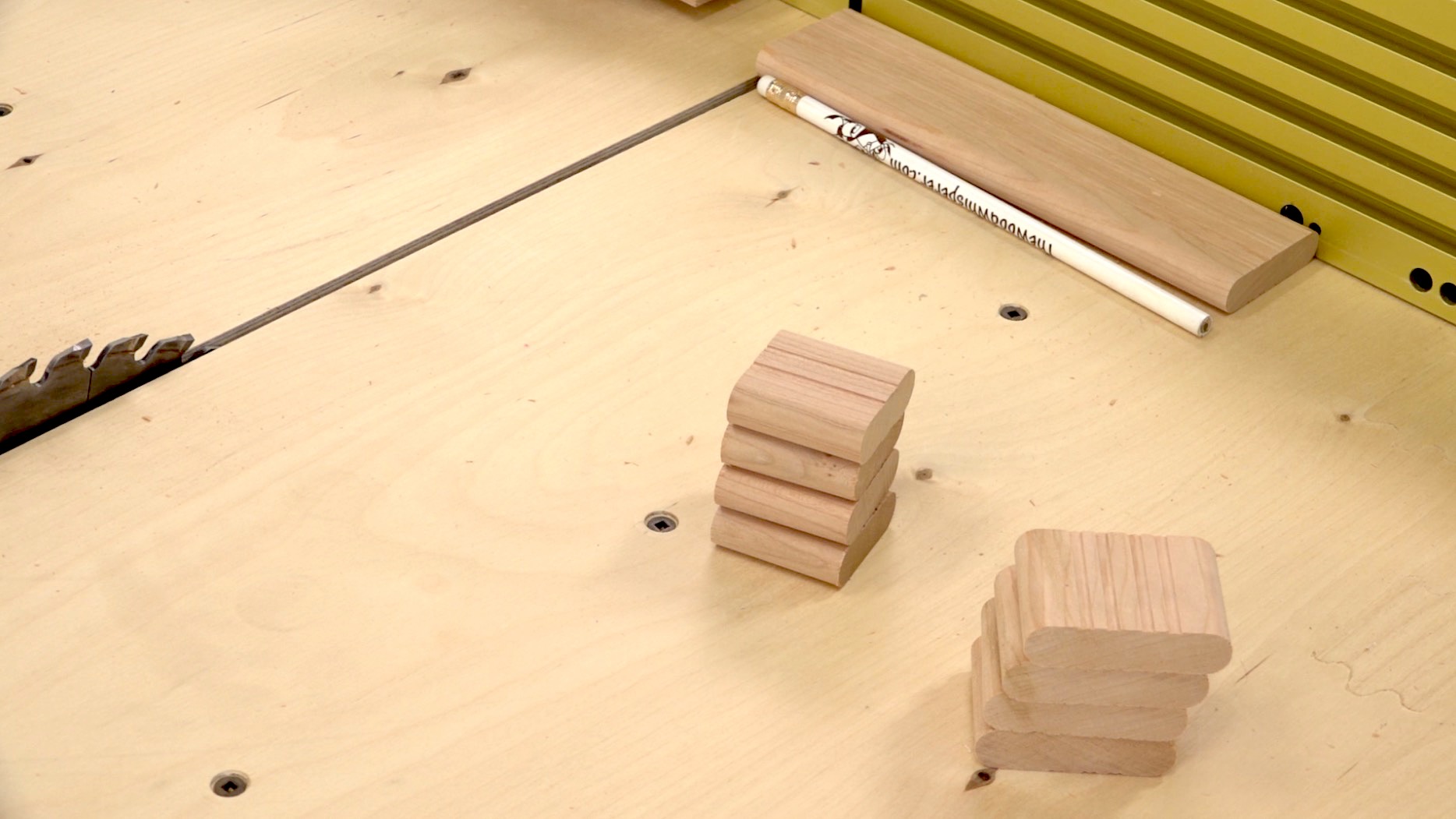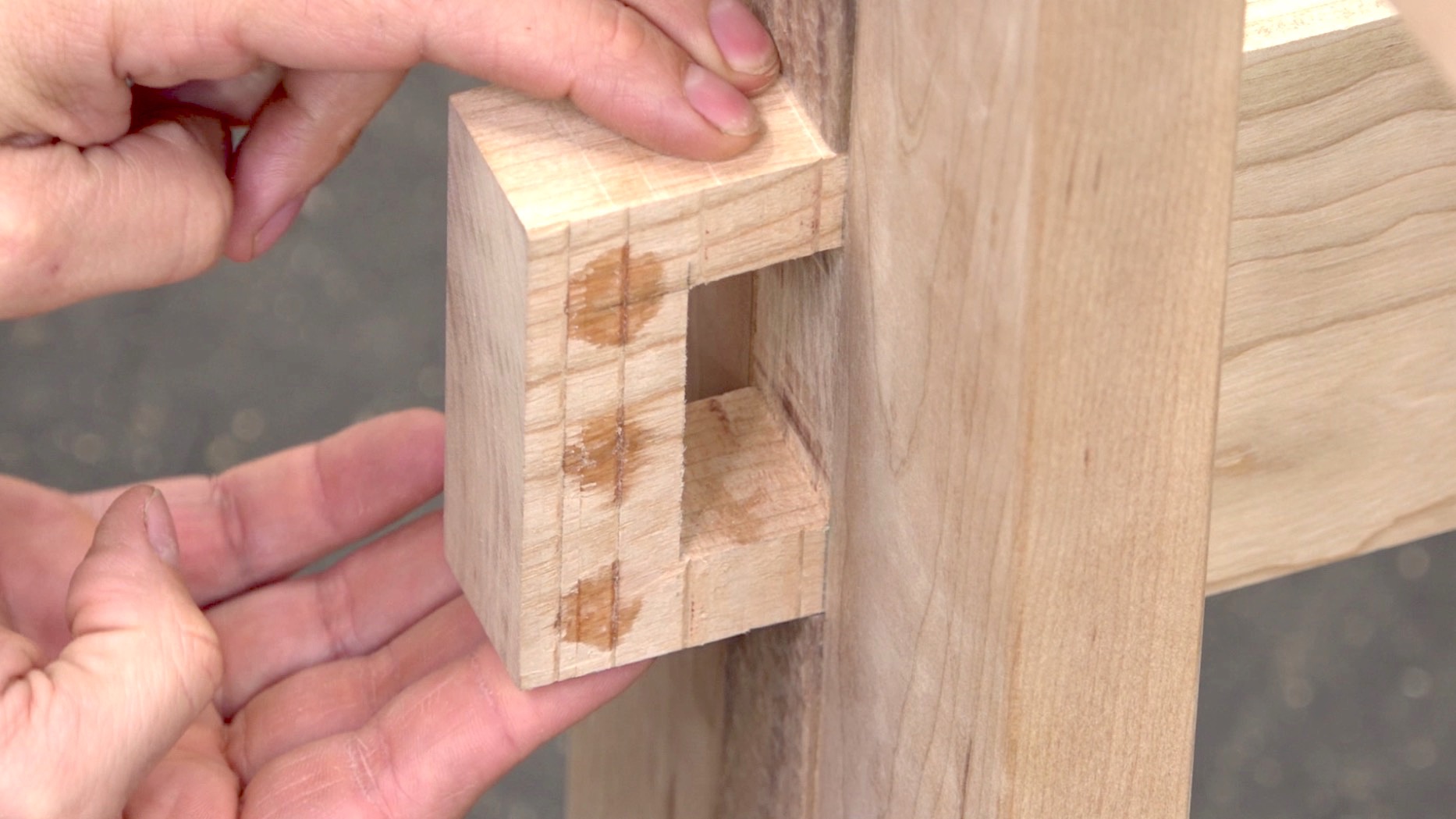Legs, Through M&T, & Dimpling – Dining Trestle Table Pt. 1
Video - March 10, 2017
Download the Plans
- SketchUp Plan
- PDF Plan and Cut List V2
- SketchUp Plan (Metric)
- PDF Plan and Cut List V2 (Metric)
- Purchase a Lumber Kit for this project
Justification
The kitchen in our new home has a cool little dining area with a built-in bench. Unfortunately, the space isn’t large enough to accommodate the Gaming Dining Table and the little freebie table we have their now just doesn’t work well. So this project is my attempt to design a table that would suit the needs of the space and our family. The table is a trestle design which keeps the legs out of the way and gives us plenty of overhang. The joinery is all mortise and tenon including some cool double wedged mortise and tenon joints. I even added extra supports in the middle of the table that will not only support the top but should also help keep the table top flat over time. Because of the joinery we employed, the table can be disassembled into lightweight and easy to move components.
Materials
We partnered with Bell Forest Products to provide wood kits specifically for this project! Check them out! The primary wood is cherry. The top is constructed from 5/4 lumber but you could certainly use 4/4 if that’s all you have access to. The base is made from 8/4 cherry and the walnut accents are also from 8/4 stock, with the exception of the wedges which can be cut from 4/4 stock or 8/4 off-cuts.
Tools
This is one of those projects where I show a number of different joinery methods and tools. You’ll see the Domino as well as router-cut through mortises and router-cut loose mortise and tenons. My goal isn’t to confuse you, but instead show you that there’s always another way to get the job done. And if you’re a fan of the Domino, the lesson on through mortises shows you that the Domino simply can’t do everything. So keeping those joinery skills sharp is essential to your success. Of course we’ll make use of the standard array of shop tools including the table saw, band saw, jointer, planer, miter saw, and even and old favorite: the die grinder.
The Legs & Easy Through Mortise & Tenons
 The table legs are a glue-up of two pieces of cherry separated by a slightly thicker piece of walnut. The walnut strip sits proud for visual effect and also allows us to create the easiest through mortise ever. Before gluing the cherry and walnut together, we can cut the walnut strip to remove a section that corresponds to the size of our mortise. When we glue everything together, we can use a spacer and some clamps to make sure the mortise is exactly the size we want and exactly consistent between our two legs.
The table legs are a glue-up of two pieces of cherry separated by a slightly thicker piece of walnut. The walnut strip sits proud for visual effect and also allows us to create the easiest through mortise ever. Before gluing the cherry and walnut together, we can cut the walnut strip to remove a section that corresponds to the size of our mortise. When we glue everything together, we can use a spacer and some clamps to make sure the mortise is exactly the size we want and exactly consistent between our two legs.
The legs, feet and supports all receive mortises for the loose tenons we’ll cut later. These are cut using a router, an edge guide, a 1/2″ spiral bit, and an extra piece of stock to help keep things balanced. The legs are then tapered on each side to offer a more bottom-heavy look to the table. The legs and supports are also tapered.
Dimpling
I thought long and hard about the walnut accent strip in the legs. I was already enjoying the look of the raised strip but thought I had an opportunity to do something even more unique. In the past I have done a dimpling texture process to create unique accents, such as the time I dimpled the drawer recess on the Krenov-Inspired Display Stand. The reception to that detail was hit or miss but in my mind that’s what trying new things is all about. So I decided to give it a shot on a much bigger scale on our Trestle Table. I’m glad I did, I think the texturing offers a subtle yet striking detail once you notice it.
Preparing for Movement
The table top is just one giant solid wood panel so we have to allow for seasonal expansion and contraction across the width at the point of connection with the base. So the two outer supports need be drilled in a specific way to allow the connector bolts we’ll use later to move back and forth slightly. I start by drilling 3/4″ holes (about 1/2″ deep) with a forstner bit. For the two inner holes, I simply drill a through hole using a 1/4″ (or slightly larger) bit. The interior holes won’t see a lot of movement. For the two outer holes, I drill two holes side by side to create a slot since that’s where the lion share of the movement will occur.
Loose Tenons
 One of the best parts of loose tenon construction is that you can make your own tenon stock and get the fit absolutely perfect. I usually make mine from longer sticks and then cut them down in the final step. Keep in mind that because of the near-perfect fit, it’s not a bad idea to cut some grooves in the face of the tenon to allow air and glue to escape. With the tenons made, the legs can be glued together with the feet and outer supports.
One of the best parts of loose tenon construction is that you can make your own tenon stock and get the fit absolutely perfect. I usually make mine from longer sticks and then cut them down in the final step. Keep in mind that because of the near-perfect fit, it’s not a bad idea to cut some grooves in the face of the tenon to allow air and glue to escape. With the tenons made, the legs can be glued together with the feet and outer supports.
The Rail Tenon
The rail tenons are a little complicated because they themselves contain a mortise. The process starts with making the tenon at the table saw and checking the fit against the mortise in the leg. Once the fit is established, a mortise is cut into the tenon itself using a router and a bearing-guided pattern bit. While we could spend a bunch of time devising some sort of jig for this, I simply use some scrap 1/4 plywood that serves as a guide for the bit. The rest of the work is done with a chisel.
After cutting my tenon I realized I made a slight mistake. I used a dado stack I don’t normally use and forgot to account for the fact that that particular stack cuts some pretty deep lines with its outer blades. Normally this wouldn’t be an issue but in the case of an exposed tenon, it’s certainly not ideal So there are a couple of reasonable options outside of remaking the entire part. One option is to use a hand plane to clean up the tenon cheeks until the grooves are gone. The key would be to only remove the material that lives outside of the mortise. This would actually change the shape of the tenon and might not look as good as it could look. The second option is to do something a little more drastic and carry through the dimpling pattern onto the tenon itself. If the dimples are cut deep enough, we could remove the lines and also add a potentially cool looking additional feature. As you’ll see in the video, I wasn’t quite so sure this was the right way to go. But writing this in the future, I can tell you that I’m perfectly happy with this choice and it turned out great (in my opinion).
In the next video, we’ll tackle the construction of the inner braces, the top, the wedges, and the finish.





